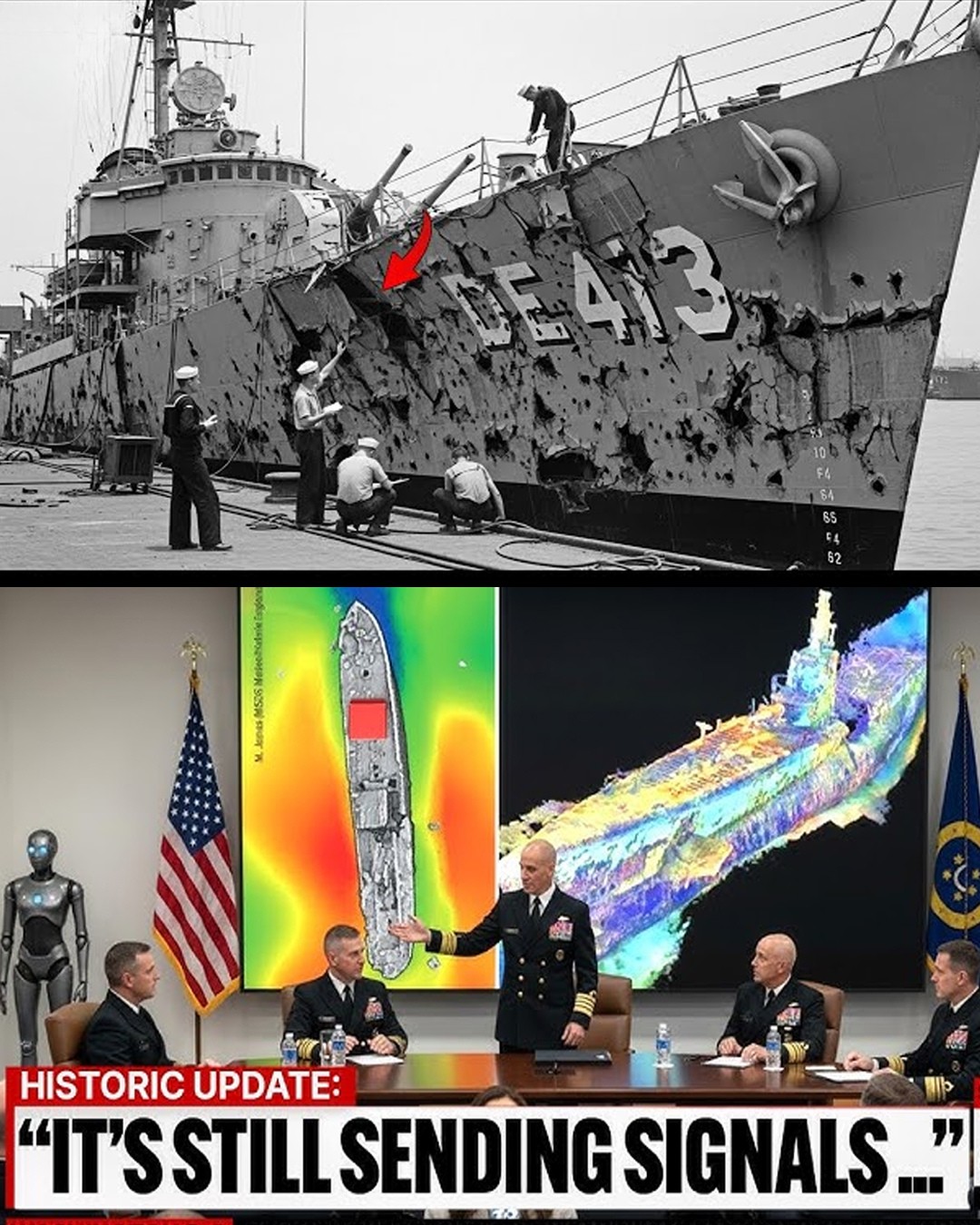Beneath the Atlantic: The Bismarck and the Deep-Sea Signal No One Has Identified
A Scientific Mystery Surrounding One of World War II’s Most Famous Shipwrecks
Three miles beneath the surface of the North Atlantic lies the wreck of the German battleship Bismarck—a vessel whose short but consequential wartime journey has been studied for decades. Since its sinking in 1941, researchers, historians, and marine archaeologists have returned many times to examine the ship’s condition, its engineering, and the circumstances of its final hours.

Recently, interest in the Bismarck resurfaced after a research team reported detecting an unusual, recurring underwater sound near the site of the wreck. The finding did not point to anything dramatic or supernatural but raised questions about deep-sea acoustics, corrosion, and the complex environment that surrounds historical shipwrecks.
Scientists are cautious in interpreting the data, yet the discovery has opened the door to new discussions about how shipwrecks behave over time and how vast, little-understood the deep ocean remains.
A Brief History of the Bismarck

Commissioned in 1940, the Bismarck was one of the largest and most powerful battleships of its era. Its design included:
-
Thick armor protecting the hull
-
Guns capable of firing over extremely long ranges
-
Advanced naval engineering for the time
The ship became widely known after the battle in which it sank HMS Hood, a flagship of the Royal Navy. Its own sinking followed soon after during a major pursuit across the Atlantic.
To this day, researchers continue to examine the historical questions surrounding its final moments, including:
-
How extensively British firepower damaged the ship
-
Whether the German crew accelerated its sinking
-
How structural failure and flooding contributed to its loss
The wreck was discovered in 1989 by Dr. Robert Ballard. Later expeditions, including those led by filmmaker James Cameron, provided detailed imaging and analysis of the ship’s internal state. Across these studies, the Bismarck has remained an important site for maritime archaeology, offering insight into naval history and deep-sea preservation.
A New Expedition and an Unexpected Acoustic Pattern

In a more recent research mission, a vessel equipped with sensitive hydrophones—devices that capture underwater sound—was operating near the Bismarck as part of a project to study ambient noise on the ocean floor.
Deep-sea sound monitoring is increasingly important for:
-
Mapping underwater ecosystems
-
Studying tectonic activity
-
Tracking marine species
-
Understanding how metal structures behave underwater
During these recordings, researchers observed a faint, periodic sound. The pattern repeated at regular intervals—roughly every nine minutes—and appeared to originate from an area close to the shipwreck.
The team emphasized that:
-
The sound was weak and difficult to localize precisely
-
It showed characteristics of an artificial noise but could have natural causes
-
The data is preliminary and requires further study
Rather than suggesting a “signal,” scientists described it simply as an unidentified acoustic event—something not unusual in deep-sea research.
Why Deep-Sea Sounds Are Hard to Interpret

The ocean is filled with sounds that are not yet fully understood. Hydrophones have captured:
-
Rhythmic vibrations caused by shifting sediment
-
Sounds created by pressure changes in underwater fissures
-
Metallic noises from corroding shipwrecks
-
Biological sounds from deep-sea creatures
-
Echoes or reflections created by ocean currents around large structures
The Bismarck, being a large metallic structure resting on a volcanic slope, exists in a highly dynamic environment. Movement along the seafloor, changes in temperature or pressure, and interactions with marine life can all contribute to acoustic activity.
Scientific Theories Under Consideration
Researchers put forward several grounded explanations for the recurring sound. None involve speculation about technology or supernatural activity. Instead, they reflect known phenomena in oceanography and materials science.
1. Corrosion-Driven Acoustic Events
Large metal structures resting at extreme depths undergo continuous corrosion.
Factors include:
-
Saltwater chemistry
-
Pressure
-
Temperature variation
-
Microbial activity
As parts of the metal weaken, collapse, or shift—especially in internal compartments—small acoustic events can occur. Periodicity may reflect environmental cycles, not deliberate patterns.
2. Geological Activity
The wreck lies on the slope of an extinct volcanic structure. Even dormant formations can experience:
-
Sediment slippage
-
Gas release
-
Slow movement triggered by pressure changes
Such processes can create repeating acoustic signatures that resemble mechanical noise.
3. Biological Sources
Deep-sea animals generate sounds for communication or movement. Certain species produce rhythmic or pulsing noises:
-
Crustaceans clicking against metal
-
Fish or squid making pressure-wave sounds
-
Species interacting with the wreck as a habitat
The regularity of the sound could reflect natural behavior cycles.
4. Instrumental Interference or Reflection
Acoustic equipment can register:
-
Echoes created by large structures
-
Reflection patterns altered by currents
-
Artifacts from overlapping frequencies
These can appear to come from a specific location even when caused by interactions between the environment and the equipment.
Why Shipwrecks Sometimes Produce Unexpected Signals
Shipwrecks are complex artificial structures in natural environments. Over time, they can act like:
-
Amplifiers
-
Resonant chambers
-
Barriers that alter current flow
-
Habitats for large numbers of marine organisms
As corrosion progresses, internal bulkheads may collapse, trapped pockets of air may shift, and metal plates may release tension. Each change can generate measurable sound.
Similar unexplained acoustic events have been documented at:
-
The Titanic
-
WWII wrecks in the Pacific
-
Submarine wrecks near Japan
-
Deep-sea drilling sites
In most cases, scientific explanations were eventually linked to structural settling or environmental factors.
Why Researchers Are Interested
Even if the sound has a mundane origin, it offers valuable data for several fields:
Maritime Archaeology
Understanding how shipwrecks evolve can help preserve historical knowledge and improve future documentation efforts.
Deep-Sea Engineering
Studying sound propagation at extreme depths can help refine underwater equipment for scientific use.
Environmental Monitoring
Acoustic anomalies help researchers track geological or ecological activity on the ocean floor.
Because the ocean is vast and largely unexplored, each new measurement helps refine models of deep-sea behavior.
What Researchers Are Doing Next
Teams intend to:
-
Revisit the site with additional equipment
-
Use triangulation to pinpoint the sound source
-
Compare seasonal data from different surveys
-
Analyze corrosion patterns to see if structural shifts correlate with the noise
No conclusion has been reached, and scientists emphasize caution. Many deep-ocean mysteries initially appear dramatic but eventually resolve into known natural processes.
Why the Mystery Captures Public Imagination
The Bismarck has long held a place in historical memory due to its dramatic wartime story and its impressive engineering. The idea of a modern acoustic reading near such a significant shipwreck naturally attracts attention.
However, researchers stress that:
-
There is no evidence of “signals”
-
No functioning machinery survives at such depths
-
No known technology on the wreck could operate after eight decades
-
Biological and geological explanations are far more probable
Public interest often rises when history, science, and mystery intersect. The Bismarck’s deep-sea location adds a layer of intrigue, but science remains grounded in data.
A Deep Ocean Still Full of Questions
The North Atlantic is a dynamic environment, full of natural forces that interact with large structures in unexpected ways. The Bismarck, although silent and long abandoned, remains subject to these conditions.
As oceanographers continue analyzing samples, recordings, and geological data, the unknown sound near the wreck represents:
-
A clue to deep-sea processes
-
An opportunity to improve acoustic technology
-
A reminder of how little of the ocean floor has been studied
The mystery is scientific rather than sensational—and it reinforces the importance of continued exploration.
Conclusion
The Bismarck is a powerful historical artifact resting in one of the most challenging environments on Earth. The recent detection of a repeating deep-sea sound near the wreck has sparked interest, but researchers stress that known natural mechanisms are the most likely explanations.
Rather than an impossible signal, the phenomenon appears to be a deep-ocean acoustic puzzle—one that future research may help solve.
